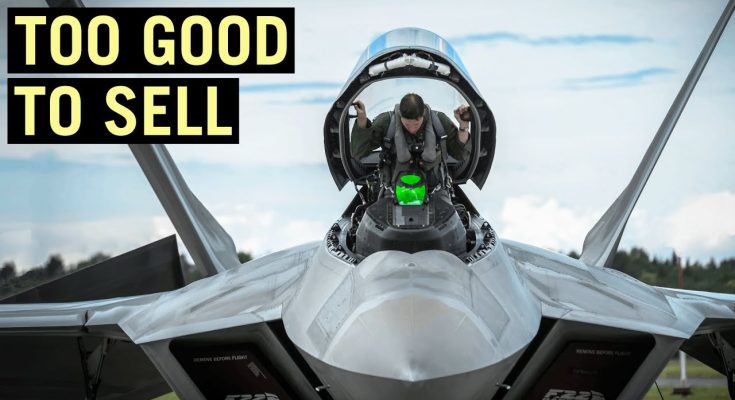The F-22 Raptor is arguably the most famous stealth fighter that the United States has never exported. As the pinnacle of fifth-generation fighter technology, the F-22 has set a benchmark for air combat, with its combination of stealth, speed, and agility. However, despite its impressive capabilities, it has remained a strictly domestic asset, and the U.S. government has chosen not to sell it to foreign nations, even those with long-standing defense partnerships.
A Revolutionary Aircraft
The F-22 Raptor was developed by Lockheed Martin for the U.S. Air Force to achieve air superiority in contested environments. Officially entering service in 2005, the F-22 was designed to be the world’s premier air combat fighter, capable of defeating both enemy aircraft and surface targets, all while evading radar detection.
Key features of the F-22 include:
- Stealth: The F-22 is designed with stealth technology to reduce its radar signature, allowing it to operate undetected by enemy radars. Its sleek design, specialized coatings, and advanced airframe minimize the chances of detection.
- Supercruise: This refers to the aircraft’s ability to fly at supersonic speeds (above Mach 1) without using afterburners. This gives it a significant advantage in terms of fuel efficiency and allows for longer range and higher speeds without compromising stealth.
- Agility: The F-22’s thrust vectoring nozzles enable it to perform extreme maneuvers in combat, making it one of the most agile aircraft in the world.
- Avionics and Sensor Fusion: The aircraft is equipped with cutting-edge avionics that combine radar, infrared sensors, and electronic warfare systems to provide the pilot with a comprehensive operational picture, ensuring superior situational awareness.
Why the F-22 Was Never Exported
Despite its clear advantages, the F-22 was not made available for export. Several factors contributed to this decision:
1. Technological Superiority
The primary reason for not exporting the F-22 was its advanced technology, particularly its stealth capabilities and sensor systems. The U.S. government feared that sharing such cutting-edge technology with foreign nations would compromise national security. This concern was especially pertinent given the possibility that adversaries might reverse-engineer the technology or use it to counteract U.S. advantages in future conflicts.
2. The 1998 “Obey the Law” Provision
In 1998, the U.S. Congress passed the “Obey the Law” provision, which specifically prohibited the export of the F-22. This law was introduced to ensure that the aircraft’s advanced technologies remained exclusive to the U.S. military and its closest allies.
3. Diplomatic and Strategic Concerns
Exporting the F-22 could have created diplomatic tensions. By limiting the sale of such an advanced asset, the U.S. maintained a strategic edge over adversaries, including Russia and China. The F-22 could have given other nations too much of an advantage, especially those with less-friendly geopolitical stances.
4. High Costs
The F-22 was an extraordinarily expensive aircraft to develop, with total program costs estimated at over $60 billion. Each unit cost around $150 million, making it prohibitively expensive for many allied nations. Even if it had been available for export, the high price tag would have limited its potential customers.
The Impact of the Export Ban
The export ban on the F-22 has had significant ramifications for the global fighter jet market. Countries like Japan and Israel, who had expressed interest in acquiring the F-22, were left with no choice but to pursue other options, such as the F-35 Lightning II, which was developed as a multirole, less expensive alternative.
While the F-35 has since become the U.S. military’s primary export fighter, it lacks the raw air superiority capabilities of the F-22. Nevertheless, the F-35’s own advanced stealth, sensor fusion, and multirole versatility have made it an attractive option for U.S. allies worldwide.
A Legacy of Air Superiority
Though it was never exported, the F-22 Raptor remains an unrivaled symbol of U.S. air dominance. It continues to serve as the U.S. Air Force’s frontline fighter for maintaining air superiority, especially in contested environments. With its unmatched performance and technological capabilities, the F-22 represents a legacy of excellence in modern fighter design.
As of 2025, the U.S. is focusing on developing next-generation fighters like the Next Generation Air Dominance (NGAD) program, which is expected to eventually replace the F-22. However, the F-22’s legacy remains intact as a fighter that only the U.S. military ever operated, reinforcing the country’s status as the leader in advanced air combat technology.
In summary, the F-22 Raptor stands as a remarkable aircraft, unmatched by any other fighter in terms of technological sophistication and performance. The decision to never export it ensured that its advanced capabilities remained a strategic advantage for the U.S. military alone.



